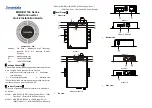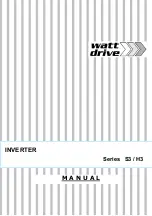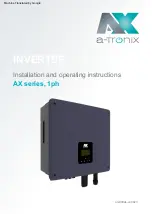
5. SM40 MODULES
5-19
5
5.5
Matrix Card - MC
LBB 1355
Eurocard 10 x 22 cm with an ‘a b’ connector (2 x 32) containing a 4 in, 8 out matrix. Extra cards can
form a 16 in, 64 out or 32 in 32 out matrix. The actual switching is activated by the CPC via the
communication line.
Matrix Card (MC) LBB 1355 enables inputs of the SM40 public address distribution centre to be routed to
loudspeakers located in geographical and/or functional zones where people must be reached with
background music, announcements and alarm signals.
Each Matrix Card, controlled by the central processor card (CPC), switches 4 line level electronically
balanced audio inputs to any or all of its 8 outputs. Up to 32 units may be connected together to form a
maximum matrix of 16 audio inputs to 64 audio outputs, or 32 audio inputs to 32 audio outputs (32 x 32).
Switching of more than one input to the same output simultaneously is prevented by the system’s software.
Signal sources for Matrix Card inputs are:
Input Cards (IPC)s (interface from 4 Call Stations); Signal Generator Cards (SGC)s (alarm and attention
tones); Signal Processing Cards (SPC)s, Tone Control Cards (TCC)s, Digital Message Cards (DMC)s,
Automatic Volume Control Cards(AVC)s, and auxiliary sources (background music players, cassette
machines, and other message devices).
Auxiliary sources are normally patched to the 4th input of the MC, which has a switch, programmable to
attenuate the music signal by 10dB when a Call Station is routed to the same loudspeaker zone. Music from
a 4th input not programmed with this option, or from another input, is automatically muted when a CST is
routed to the same zone.
Matrix card outputs may be connected to:
Signal Processing Cards (SPC)s; Tone Control Cards (TCC)s; Automatic Volume Control Cards
(AVC)s; direct to amplifier inputs; or to the mixing inputs of other MCs, using a flat cable plugged into
their coupling connector.
When forming a larger matrix, cards are “addressed”; meaning that they are given specific places in the total
matrix, by repositioning 2 sets of jumpers on each card. In a matrix of 32 cards, the MCs are be divided into
two groups, (I and II), and numbered 1 to 16. It should be noted that when using the 1st address selection
blocks to address the cards to a group, both jumper plugs must be in the same position: either a-c for group
1, or a-b for group 2 (see circuit card layout drawing).
A card’s address in the matrix will determine which set of inputs and outputs it is assigned. For instance if a
card is addressed I-7 in a 16 x 64 matrix system, it will receive signals from inputs 1 to 4, and feed outputs
49 to 56. This is easiest understood by referring to the accompanying ‘Total Matrix’ block diagram.
Dependent on how the MCs are addressed, a large number of system configurations are possible. For
instance, certain Call Stations may be switchable to a large number of speaker zones, while others in the
same system are switchable to only a limited number of zones. A few of the many possible configurations are
shown in the system block diagrams later in this information.
Each MC input, though electronically balanced, has a jumper mounted on the card which, when
repositioned, enables it to accept an unbalanced signal from an auxiliary source.
It should be noted that, in line with Philips’ commitment to reliability, the short circuit of an input will not
effect the other inputs.
A yellow LED is mounted on the front edge of the card to advise that the unit is in communication with the
Central Processor, and 3 green LEDs indicate that adequate supply voltage is present.
Summary of Contents for LBB 1330
Page 2: ......
Page 4: ...SM40 SOUND DISTRIBUTION SYSTEM ii This page has been left blank intentionally ...
Page 6: ...1 GENERAL INTRODUCTION AND OPERATING PRINCIPLES 1 ...
Page 8: ...1 GENERAL INTRODUCTION AND OPERATING PRINCIPLES 1 2 1 ...
Page 10: ...1 GENERAL INTRODUCTION AND OPERATING PRINCIPLES 1 4 1 ...
Page 12: ...2 UNPACKING AND INSTALLATION 2 ...
Page 16: ...3 SM 40 BASIC SYSTEM AND EXTENSION FRAME 3 ...
Page 18: ...3 SM 40 BASIC SYSTEM AND EXTENSION FRAME 3 2 3 ...
Page 20: ...3 SM 40 BASIC SYSTEM AND EXTENSION FRAME 3 4 3 ...
Page 21: ...3 SM 40 BASIC SYSTEM AND EXTENSION FRAME 3 5 3 ...
Page 22: ...4 OPERATING AND PROGRAMMING THE SM40 SYSTEM 4 ...
Page 60: ...5 SM40 MODULES 5 ...
Page 64: ...5 SM40 MODULES 5 4 5 ...
Page 66: ...5 SM40 MODULES 5 6 5 ...
Page 68: ...5 SM40 MODULES 5 8 5 ...
Page 70: ...5 SM40 MODULES 5 10 5 ...
Page 77: ...5 SM40 MODULES 5 17 5 This page has been left blank intentionally ...
Page 78: ...5 SM40 MODULES 5 18 5 b a c ...
Page 80: ...5 SM40 MODULES 5 20 5 IMPORTANT Ensure the interconnection cable is positioned correctly ...
Page 81: ...5 SM40 MODULES 5 21 5 ...
Page 82: ...5 SM40 MODULES 5 22 5 ...
Page 84: ...5 SM40 MODULES 5 24 5 ...
Page 85: ...5 SM40 MODULES 5 25 5 ...
Page 86: ...5 SM40 MODULES 5 26 5 ...
Page 88: ...5 SM40 MODULES 5 28 5 ...
Page 90: ...5 SM40 MODULES 5 30 5 ...
Page 92: ...5 SM40 MODULES 5 32 5 ...
Page 94: ...5 SM40 MODULES 5 34 5 ...
Page 96: ...5 SM40 MODULES 5 36 5 ...
Page 97: ...5 SM40 MODULES 5 37 5 ...
Page 98: ...5 SM40 MODULES 5 38 5 Surveillance Message Switch Card ...
Page 100: ...5 SM40 MODULES 5 40 5 ...
Page 101: ...5 SM40 MODULES 5 41 5 This page has been left blank intentionally ...
Page 106: ...5 SM40 MODULES 5 46 5 SM40 PHILIPS 6 7 8 9 10 1 2 3 4 5 CALL STATION LBB 9567 ...
Page 108: ...5 SM40 MODULES 5 48 5 ...
Page 110: ...5 SM40 MODULES 5 50 5 ...
Page 112: ...5 SM40 MODULES 5 52 5 ...
Page 113: ...5 SM40 MODULES 5 53 5 ...
Page 114: ...5 SM40 MODULES 5 54 5 ...
Page 115: ...5 SM40 MODULES 5 55 5 ...
Page 116: ...5 SM40 MODULES 5 56 5 ...
Page 117: ...5 SM40 MODULES 5 57 5 ...
Page 118: ...5 SM40 MODULES 5 58 5 ...
Page 120: ...5 SM40 MODULES 5 60 5 This page has been left blank intentionally ...
Page 135: ...6 REMOTE PROGRAMMING 1 O PROTOCOL 6 15 6 This page has been left blank intentionally ...
Page 139: ......
















































